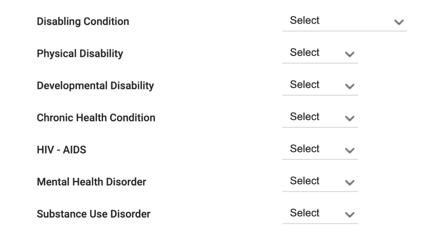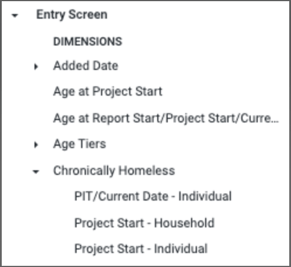Chronic Homelessness
This article describes how the data entered for a client’s disabling condition(s) and prior living situation determine their chronic homelessness status.
Overview
The Department of Housing & Urban Development (HUD) describes individuals as being “chronically homeless” when they meet the following conditions:
- They have a disabling condition.
- They are currently experiencing literal homelessness.
- They have experienced literal homelessness for 12 consecutive months OR at least four episodes totaling at least 12 months over the past three years, with breaks separating the episodes totaling at least 7 consecutive nights.
OR
- They have resided in an institutional care facility for fewer than 90 days and met the above criteria before entering the facility.
A family is considered to be “chronically homeless” when the Head of Household meets the above definition.
Because the provision of certain housing services is prioritized for chronically homeless persons/households, it is important to accurately record a client’s disabling condition(s) and living situations in Clarity Human Services.
The data for determining whether the client meets the conditions of the “chronically homeless” definition, which is collected on the enrollment screen for a program in Clarity Human Services, is described below.
Disabling Condition
To meet the first part of the “chronically homeless” definition, an individual must have a disabling condition. In Clarity Human Services, this means that there must be a response of “Yes” for at least one of the conditions shown below.

Prior Living Situation
The other part of the “chronically homeless” definition looks at where the individual has been living (their “prior living situation”) and how long they have been living there.
An individual with a disabling condition is considered “chronically homeless” if they have been homeless (living in a place not meant for habitation, an emergency shelter, or a safe haven) continuously for at least 12 months or for at least four separate occasions totaling at least 12 months over the past three years.
An individual can also be considered “chronically homeless” if they have been in an institutional care facility for less than 90 days and met the above definition before entering the facility.
In Clarity Human Services, the Type of Residence field is where you enter an individual’s prior living situation. The Length of Stay in Prior Living Situation field is where you enter the length of time spent in that situation.
- The first three responses in the Type of Residence picklist are the ones that indicate possible chronic homelessness (Place not meant for habitation, Emergency shelter, or Safe Haven).

If you select one of those three responses, then you’ll need to complete additional fields. The responses to these fields will be used to determine whether the individual meets the timeframe requirements for the “chronically homeless” definition.
- The next six responses for Type of Residence indicate that the individual has been living in an institutional situation.

If you select one of those six responses, then you’ll need to select whether the stay in the institution was less than 90 days. If the response is “Yes,” you’ll need to complete additional fields. The responses to those fields will be used to determine whether the individual’s living situation prior to the institutional stay meets the “chronically homeless” definition.
Entering accurate information for the fields described above will help prioritize the provision of housing services to the clients with the greatest need.
Eligibility Preset for Chronic Homelessness
Communities may find it helpful to configure an Eligibility Preset for chronic homelessness, such as the example shown here, so that the requirements can be copied into to Programs, Funding Sources, Sites, Buildings, Unit Configuration Types, or Units without having to reconfigure them each time.

Reporting on Chronically Homeless Clients
Looker
Looker has three fields that follow the logic outlined in HUD's Standard Reporting Terminology Glossary to calculate chronicity:
- PIT/Current Date - Individual
- Only available to ES, SO, and SH project types.
- Project Start - Household
- Project Start - Individual
These fields are available under the “Chronically Homeless” dropdown within the “Entry Screen” view in the HMIS Performance, Data Quality, Client, and Coordinated Entry models.

Report Library
Several reports in Clarity Human Services' Report Library, such as the [GNRL-108-AD] Chronic Homeless Program Enrollment Report and the [GNRL-220] Program Details Report, provide details on chronically homeless clients.
Updated: 10/04/2024